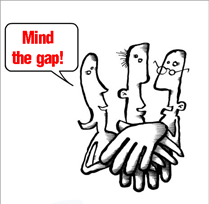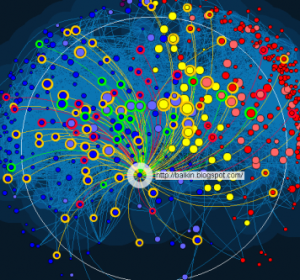Archive for June, 2008
 |
27. June 2008 – 13:27 by Asociacion Ciudades Kyosei / Pedro Prieto-Martin
|

As most of you already know, our national, regional and local governments have so far failed to fully exploit the collaborative potential of the Internet. The most celebrated e-Democracy experiences have been modest experiments with little real effect and almost no continuity or scalability. e-Participation poses serious conflicts of interests to political elites and civil servants, who would like to have more legitimacy because of citizen participation… but nevertheless want to retain their discretionary decisional power. These e-Participation experiences have cost too much and have brought too few change and benefits.
In order to stimulate citizens’ trust in e-Participation, it is necessary to promote experiences coming from Civil Society, which while still granting authorities the privileged role they deserve regarding participation, withdraw from them an “absolute” power and control.
Our spanish-based association, the “Asociación Ciudades Kyosei”, aims to provide a free non-partisan environment to foster municipal civic participation. NGOs, citizens, civil servants, politicians & media will be provided with tools to communicate, discuss, carry out participatory processes, coordinate internal work, etc. This environment, whose name is Kyosei-Polis, will provide e-Participation tools to any organization -first of all: public authorities- willing to involve citizens to work for the “common good”. It will also help concerned citizens to find each other and facilitate their mobilization and action, thus enabling them to exert pressure on local authorities to take participation seriously and to act accordingly. This may be the best strategy to expand e-participation’s reach and depth.
Our environment will be a FOS (Free and Open Source) System, and our aim is to make it sustainable both in developed and developing countries. The research, design and construction of the system is being planned with an interdisciplinary and collaborative approach, incorporating socio-political, technical and participative components. Because this is not just software, but software for (political) development, we have taken a very innovative approach: we are extending the collaborative practices of Open Source to include the design phase. This way, we are creating processes which allow representatives from all systems’s future stake-holders to easily contribute with their knowledge and expertise, to create a system that fully addresses its necessities and concerns.
We are placing an utmost attention on the sustainability of the system (technical, institutional and financial). Sustainability is attained when the different system’s users and stake-holders perceive it as “useful”, which will happen when the benefits they obtain with the system are worth the effort they invest using it. This may sound “obvious”, but no eParticipation system created so far has been able to address it satisfactorily.
Experts coming from various disciplines are contributing to the project on an voluntary basis, under the coordination of the Association and with the support of the University of Alcalá (Spain). We have lately applied for a grant from the spanish Ministry of Industry, to complete our system’s first alpha release and carry out several pilot experiences.
We hope that, by becoming an associated member of PEP-Net, we will be able to learn a lot from the perspectives of its various members, and contribute to the difussion of an open-minded view of e-Participation.
For more information please visit: www.ckyosei.org
Posted in Projects, members | 4 Comments »
 |
26. June 2008 – 08:00 by Rolf Luehrs
|
OneWebDay is September 22 every year, starting 2006. The focus is always on one key value of the Internet and this year it’s online participation in Democracy!

The Web is worth celebrating and
…we all - everyone around the physical globe - can celebrate the Web and what it means to us as individuals, organizations, and communities.
As with Earth Day - an inspiration and model for OneWebDay - it’s up to the celebrants to decide how to celebrate. We encourage all celebrations! Collaboration, connection, creativity, freedom.
By the end of the day, the Web should be just a little bit better than it was before, and we’ll be able to see our connection to it more clearly.
All information on how to participate and lots of OWD stories can be found on the website. Since this years focus is on eParticipation, we think that PEP-NET should definitely celebrate the OneWebDay. The question is how? Any ideas?
Posted in TuTech | 3 Comments »
 |
25. June 2008 – 16:41 by Danish Technological Institute
|
On 18 June 2008 Casaba Madarasz from Option.hu Ltd. in Hungary became person number 100 to register as a member of the eParticipation and eDemocracy Network on www.epractice.eu.
The eParticipation and eDemocracy Network is open to all interested in these issues, whether at sub-national, national, European or trans-national levels. The issues covered are potentially broad and often interconnected and includes eEngagement, eDeliberation, eInvolvement, eLegislation and eVoting, as well as eDecision, eRule and ePolicy-making.
To date 103 people are registered as member of the eParticipation and eDemocracy Network. For further details see www.epractice.eu/community/eParticipation
Morten Meyerhoff Nielsen, Business and Policy Analysis, Danish Technological Institute
Posted in News | 3 Comments »
 |
25. June 2008 – 13:47 by Madarász Csaba
|
post by Madarász Csaba, e-participation project leader of the CEE Citizens Network
The communicational and technical trends of the internet are offering a wide range of possibilities for channeling communication based contribution from various entities of the society (Artificial Intelligences are a bit behind us).
It is likely to know, that the core values of e-participation are coming from communication.
Although, it might seem, that technology has created this opportunity, but of course this is half of the truth - communication and communicational policy itself is the core factor for more than 50% of the success of e-participation projects , as it is the success factor of non-e participatory projects for 100%,
From the traditional particpation methods practicioner’s point of view (as most of our network members) there is a huge communication gap in Europe around this issue.
Read the rest of this entry »
Posted in Trends | No Comments »
 |
25. June 2008 – 10:38 by Bengt Feil
|
The online campaigns in the US presidential election 2008 gain momentum every day and with them the political comments by citizens on Web2.0 websites. There is for example a huge number of political bloggers who comment on the candidates, discuss issues and try to make their mark on the elections. One of the problems of the wide variety of voices in this discussion is that it is nearly impossible to get an overview about it. PresidentialWatch08.com tries to encounter this problem by visualisation.

The websites uses a technology provided by Linkfluence which allows drawing a map of hundreds of political blogs, their interaction and their alignment without making the overview to complicated. The interface allows selecting different parts of the political blogosphere and getting one-click information about all the blogs shown. The most interesting things may by that this kind of visualisation allows us to understand the complex interaction going on in the blogosphere at any given point of time.
It may be interesting to discuss where such a visualisation could also be used to understand deliberative processes in the web and to harness the knowledge created in these processes.
Posted in Tools, good practice | No Comments »
 |
25. June 2008 – 10:28 by Rolf Luehrs
|
As PoliticsOnline reported the online pro-drilling petition which President Bush and Sen. McCain recently endorsed, has generated more traffic than the anti-McCain ad published by MoveOn.org. The Drill Here, Drill Now, Pay Less online petition urges the U.S. Congress to “act immediately to lower gasoline prices (and diesel and other fuel prices) by authorizing the exploration of proven energy reserves to reduce our dependence on foreign energy sources from unstable countries.”

Former House Speaker Newt Gingrich’s American Solutions Group has figured out how to run a successful viral campaign, offering its supporters an investment widget, a petition widget, an option to endorse the campaign on your site, banners supporting the movement, a YouTube campaign site, a Solutions lab, and an “action pack” which includes a printable version of the ‘Drill Now’ petition. So far, over 73,000 people have made online donations to fuel the ‘Drill Now’ petition. All of the supporters receive a free bumper sticker, which helps spread the virtual movement offline.
ePetitions – although reaching incredibly high numbers of participants – have been criticised for different reason. As Fraser has been pointing out in this blog “there is concern that such exercises in eDemocracy are nothing more than an electronic registering of dislike. Equally that, contrary to claims of engaging with the public, online petitions could, in the words of one Parliamentarian, ‘produce disaffection, as people register their dislike … and then nothing happens’”.
The pro-drilling campaign is different in that it demands concrete action instead of just registering complaints. At the same time this case demonstrates that ePetitions can be used very well as an efficient tool for top down initiated political campaigns. Is this still considered eParticipation?
Posted in News, Trends | No Comments »
 |
25. June 2008 – 10:27 by christophdowe-politik-digital.de
|
Think before you act! Before setting up online communication tools, you need an communication strategy first! Don´t use Blogs and Social Media as means without ends - if you want to reach people, who should have something to say!
This sounds like good old common sense to most eDemocracy advocators and long-time practioners. But this low-level approach might fit best to reach not so web-savvy politicians and people who are new on the field of online politics.
The free e-book “Online Politics 101: The Tools and Tactics of Online Advocacy” exactly aims at these people. Written by Colin Delayne, web-consultant, founder and editor of e.politics.com, the report introduces “candidates, advocacy organisations, corporate interests and everyday citizens” to online politics and advocacy tools, from the very basic as Websites and Search Engine Optimizing (SEO) to E-Mail-Lists, Blogs, and Social Media. The e-book has recently been updated and now contains sections about how to use tools as Facebook and Twitter for promoting candidates or shaping opinions.
Delayne explains all these tools in plain English, stressing that which tool to use and how to use it depends on your targetgroup as well as on what you want to achieve. Fine thing is, most of his tips apply international (although tools like Google ads or text messaging for political means are not broadly used in Germany).
Simone Gerdesmeier (politik-digital.de)
Posted in News, Tools, good practice | No Comments »
 |
24. June 2008 – 20:27 by Zebralog / Hans Hagedorn
|
Mobile Participation (mParticipation) seems to be the next step in ePartizipation. With the rising of the iPhone and other smart phones and combined with other features like GPS and Location Based Services the expectations for new applications for are high. Consequently mobile applications amplify eParticipation in an spatial and temporal dimension. Not only at home, but also e.g. traveling in the metro, participants are enabled to read, write and follow the discussions.
But in contrary to the expectations the realization is underachieved. Maybe this is caused by the difference between possible applications and the actual use of cell phones. Research studies dealing with the use of cell phones, draw this conclusion. Even if around 40 % of cell phones users have smart phones, only around 20% use the mobile internet. Questioned what features of the personal cell phone are used, the majority names phonecalls and SMS (around 85% - 93%; depending to the survey). All other services are far behind. E.g. only 20 % send photos or videos via their mobile phone, but around 85% use SMS.
Even if SMS only offer limited possibilities (because of the restriction to 160 signs) in comparison to mobile internet devices, there are arguments for integration in participation processes. They are an easy to use feature, they are cheap, they can be integrated to web (and vice versa). Looking at demoscopic data, they even offer more advantages. The diffusion is higher - 93 % in comparison to around 60% of the internet. Additionaly the use of the internet is affected by income and education, which is less significant at the use of mobile phones. Following this data, the integrations of SMS offer the chance to integrate less educated and poorer people.
The challenge is to develop formats, by combining both media. Shown at the campaign Mindestlohn, collections of signatures can be one of the possible application. Another option is the integration in location based projects, like city development projects. While missing internet access in situ, information could be given via audio-podcasts (which can be listened via the phone) and passer-bys could send a first statement (“Send A for the first alternative, and B for alternative B”). The reply-SMS could contain further information.
The future of mParticipation will be the mobile internet, but for current projects, the low-tech applications SMS and Audio offer the bigger participation potential.
Stefan Höffken (Zebralog Berlin)
Posted in Trends | 4 Comments »
 |
23. June 2008 – 13:55 by Rolf Luehrs
|
The e-Governance Academy (Estonia) in cooperation with the European University Institute in Florence will host a webinar on e-tools for active citizens participation. These tools have been developed in the TID+ project part-financed by the European Commission.
The main result of TID+(…) is a FOSS software tool that that can be used to organise citizen-driven e-participation.
We will tell you more about the project and we’ll provide a short demonstration. There will be ample opportunity for you to ask questions and enter into discussion.
The webinar will take place on Friday, June 27, 2008 10:00 AM - 12:30 PM CEST. Potential participants should register here.
Posted in TuTech | 2 Comments »
 |
23. June 2008 – 11:36 by Bengt Feil
|
This is the title of the book written by Clay Shirkys discussing the development of the internet towards a user generated web – nothing new on first glace. This topic has been discussed for a long time already but the dimensions of these developments have changed dramatically over the course of the last two years. Websites which are based on content and activity produced by users have found their way into the mainstream. This is clearly visible for the English speaking net. In Germany this trends seems to be strong too.
Among the Top 50 websites of the world (End of 2007) are 15-20 (depending on the used definition) which almost exclusively depend on user generated content. To put this into perspective: DIGG.com counts 26 million individual visitors on its site per month and is on rank 32 of the top 50 list. Websites like Myspace, Wikipedia or Youtube are much higher in the ranking.
If one takes a look on such ranking for German websites one could assume that this trend is not reflected here. Among the Top 50 sites (AGOF) there are eight which are mostly user generated. But this angle does not take into account that most of this kind of usage form German users happens on English speaking and especially American websites. 3.6% of all Myspace users and 7% of all visitors to Wikipedia.org are from Germany. Keeping this in mind this kind of internet use seems to be in the mainstream in Germany as well.
Of course not all of these users are active in the sense that they provide content themselves but the importance of user generated media for the net is obvious. Maybe Clay Shirky should call the second version of this book “Here is everybody”!
Posted in Trends | No Comments »











